|  | | | | 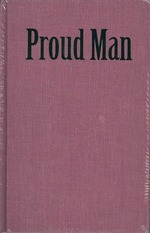

| | Proud Man
by Katharine Burdekin (as by Murray Constantine)
First publication: 1934

An androgynous traveler—initially known as the Person, then as Verona, and finally as Gifford Verona— communicates with the subhumans called Englishmen about a time thousands of years in the the future of 1930’s England. To return to my dream, this person thought that either you or I should go among these subhumans, and yoiu, though willing to go, were a shade less willing than I. So it was decided that I was to go, and when I asked this person, who had been thinking to us about these creatures, how I should come to them, seeing that they were either on another planet or in another time, the way thither was made clear to me, for all I had to do was to wish to be there with them, and there, wherever or whenever it was, I should be. To return to my dream, this person thought that either you or I should go among these subhumans, and yoiu, though willing to go, were a shade less willing than I. So it was decided that I was to go, and when I asked this person, who had been thinking to us about these creatures, how I should come to them, seeing that they were either on another planet or in another time, the way thither was made clear to me, for all I had to do was to wish to be there with them, and there, wherever or whenever it was, I should be.
 I am much inclined to think it was not on another planet, but on the same planet in another time. I am much inclined to think it was not on another planet, but on the same planet in another time. 
| |
| | | | |

 | | | | 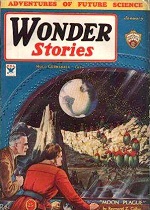 | | “To-Day’s Yesterday”
by Russell Blaiklock (as by Rice Ray)
First publication: Wonder Stories, Jan 1934

Cavanaugh, a movie’s sound engineer, realizes that the complex wiring on the movie set has transported a microphone to another time, and Cavanaugh’s assistant, Wilson, then transports himself to that time, too. | |
| | | | |

 | | | | 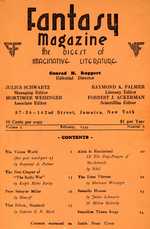

| | “The First Chapter of the Radio War”
aka “The Missing Chapter of the Radio War”
by Ralph Milne Farley
First publication: Fantasy Magazine, Feb 1934

As we all know, the 1932 story, The Radio War, of how John Farley Pease fought the Siberians in the year 2000 involved no time travel. But wait! Just how did Ralph Milne Farley get ahold of the story of the future Pease’s war exploits? That story was told in the 1934 fanzine, Fantasy Magazine (published by megafans Julius Schwartz, Ray Palmer, Mortimer Weisinger, and Forry Ackerman) as a missing part of the first chapter of The Radio War. In addition to his various tricks of magic, this young Chinaman had another typically Oriental trait, namely that of being able to commune with his ancestors. In addition to his various tricks of magic, this young Chinaman had another typically Oriental trait, namely that of being able to commune with his ancestors. 
| |
| | | | |

 
 | | | | 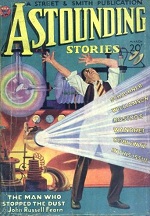 | | “The Retreat from Utopia”
by Wallace West
First publication: Astounding, Mar 1934

A newspaper reporter from 2175 describes his strict, puritan world where nobody is happy because nothing ever happens, and even the criminals off in Borneo refuse to rejoin that society, so the story’s 1934 narrator visits the future to set things right. | |
| | | | |

 
 
 | | | | 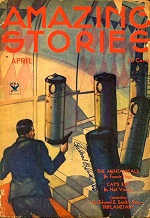

| | “The Mentanicals”
by Francis Flagg
First publication: Amazing, Apr 1934

On a whim, the handsome Captain Bronson, adventurer and yacht captain for the multimillionaire Olson Smith, steps into the time machine of the quirky Professor Stringer and presses the Wellsian lever forward, whereupon he finds himself in a future world populated by stupid beastly men and smooth, cylindrical robots. Professor Stringer threw open the laboratory door and turned on the lights. We saw it then, an odd machine, shiny and rounded, occupying the center of the workshop floor. I had been drinking, you will recollect, and my powers of observation were not at their best. It was the same with the others. When I questioned them later, they could give no adequate description of it. “So this,” said Olson Smith rather flatly, “is a time machine.” The doctor walked about—a little unsteadily I noticed—and viewed it from all angles. “The passenger,” said the Professor, “sits here. Notice this lever on the graduated face of the dial; it controls the machine. Turn it this way from Zero and one travels into the past; throw it ahead and one travels into the future. The return of the lever to Zero will return the machine to the point of departure in time. The electronic flow. . . .” he went into obscure details. “Will it work?” demanded the Doctor. Professor Stringer threw open the laboratory door and turned on the lights. We saw it then, an odd machine, shiny and rounded, occupying the center of the workshop floor. I had been drinking, you will recollect, and my powers of observation were not at their best. It was the same with the others. When I questioned them later, they could give no adequate description of it. “So this,” said Olson Smith rather flatly, “is a time machine.” The doctor walked about—a little unsteadily I noticed—and viewed it from all angles. “The passenger,” said the Professor, “sits here. Notice this lever on the graduated face of the dial; it controls the machine. Turn it this way from Zero and one travels into the past; throw it ahead and one travels into the future. The return of the lever to Zero will return the machine to the point of departure in time. The electronic flow. . . .” he went into obscure details. “Will it work?” demanded the Doctor. 
| |
| | | | |

 
 
 
 
 | | | | 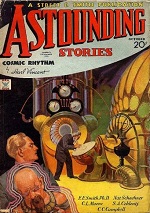 | | “Inflexure”
by H.L. Gold (as by Clyde Crane Campbell)
First publication: Astounding, Oct 1934

 Some rogue object passing through the solar system manages to merge together all people from all times of Earth. Some rogue object passing through the solar system manages to merge together all people from all times of Earth. I’m over the Caroline Islands, longitude 158° 23´ west, latitude 8° 30´ north. There’re millions of people drowning all around me. What shall I do? I’m over the Caroline Islands, longitude 158° 23´ west, latitude 8° 30´ north. There’re millions of people drowning all around me. What shall I do? 
H.L. Gold, Master Traveller H.L. Gold wrote the earliest story of different eras living side-by-side because of some sort of time storm or, as he called it, an “Inflexure.” But even without that innovation, Gold would deserve an award for the volumes of time travel stories he published as the first Galaxy editor.

| |
| | | | |

 | | | | 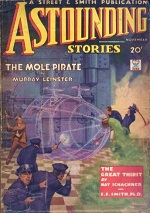

| | “Twilight”
by John W. Campbell, Jr. (as by Don Stuart)
First publication: Astounding, Nov 1934

 In 1932, James Waters Bendell picks up a magnificently sculpted hitchhiker named Ares Sen Kenlin (the Sen means he’s a scientist, but Waters is just a name) who says that he’s trying to get back to his home time (3059) from seven million years in the future—a time when mankind has atrophied because of their reliance on machines. In 1932, James Waters Bendell picks up a magnificently sculpted hitchhiker named Ares Sen Kenlin (the Sen means he’s a scientist, but Waters is just a name) who says that he’s trying to get back to his home time (3059) from seven million years in the future—a time when mankind has atrophied because of their reliance on machines. They stand about, little misshapen men with huge heads. But their heads contain only brains. They had machines that could think—but somebody turned them off a long time ago, and no one knew how to start them again. That was the trouble with them. They had wonderful brains. Far better than yours or mine. But it must have been millions of years ago when they were turned off, too, and they just hadn’t thought since then. Kindly little people. They stand about, little misshapen men with huge heads. But their heads contain only brains. They had machines that could think—but somebody turned them off a long time ago, and no one knew how to start them again. That was the trouble with them. They had wonderful brains. Far better than yours or mine. But it must have been millions of years ago when they were turned off, too, and they just hadn’t thought since then. Kindly little people. 
John W. Campbell, Jr., Master Traveller Campbell’s three time travel stories were published under his pseudonym of Don Stuart before he took over the reins of Astounding, and even together they would not justify the prestigious Master Traveller Citation. But the number of classic time travel yarns he brought to light at Astounding and Analog make him more than worthy.

| |
| | | | |

 
 
No Time Travel. Move along. |
Before the Dawn by Eric Temple Bell [viewing the past ]

| |     |